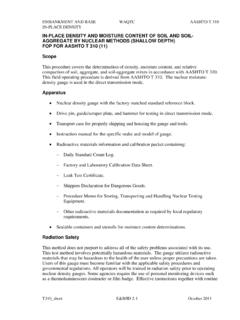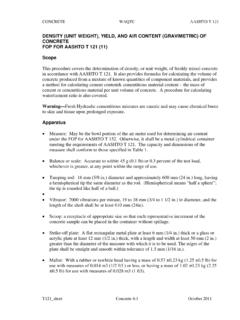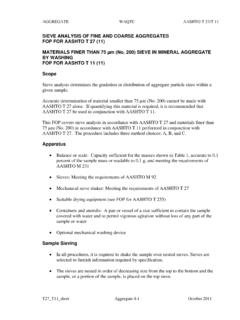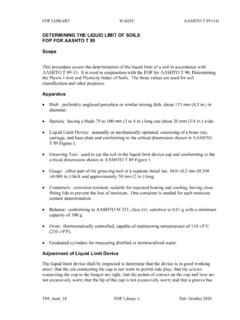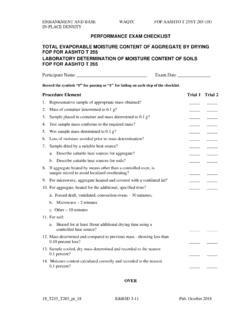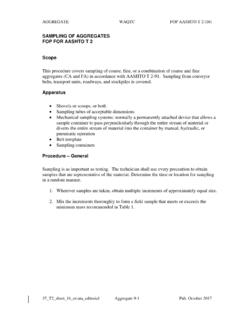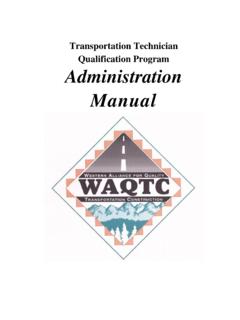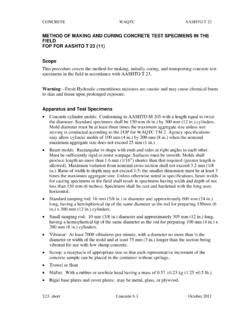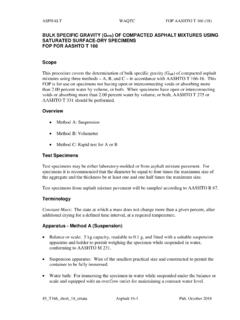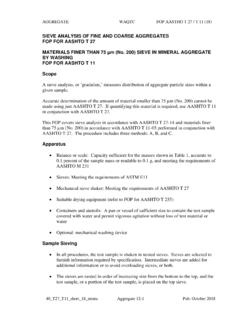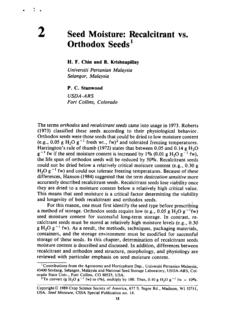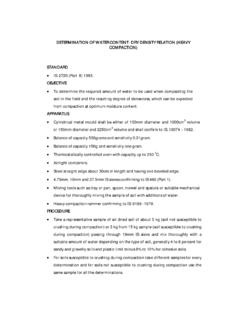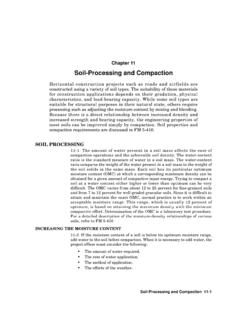Transcription of FOP AASHTO T 99 / T 180 (17) - WAQTC
1 EMBANKMENT AND BASE WAQTC FOP AASHTO T 99 / T 180 (18) IN-PLACE DENSITY 47_T99_T180_short_18_errata E&B/ID 14-1 Pub. October 2018 moisture -DENSITY RELATIONS OF SOILS: USING A kg ( lb) RAMMER AND A 305 mm (12 in.) DROP FOP FOR AASHTO T 99 USING A kg (10 lb) RAMMER AND A 457 mm (18 in.) DROP FOP FOR AASHTO T 180 Scope This procedure covers the determination of the moisture -density relations of soils and soil-aggregate mixtures in accordance with two similar test methods: AASHTO T 99-18: Methods A, B, C, and D AASHTO T 180-18: Methods A, B, C, and D This test method applies to soil mixtures having 40 percent or less retained on the mm (No.)
2 4) sieve for methods A or B, or, 30 percent or less retained on the 19 mm ( in.) with methods C or D. The retained material is defined as oversize (coarse) material. If no minimum percentage is specified, 5 percent will be used. Samples that contain oversize (coarse) material that meet percent retained criteria should be corrected by using Annex A , Correction of Maximum Dry Density and Optimum moisture for Oversized Particles. Samples of soil or soil-aggregate mixture are prepared at several moisture contents and compacted into molds of specified size, using manual or mechanical rammers that deliver a specified quantity of compactive energy.
3 The moist masses of the compacted samples are multiplied by the appropriate factor to determine wet density values. moisture contents of the compacted samples are determined and used to obtain the dry density values of the same samples. Maximum dry density and optimum moisture content for the soil or soil-aggregate mixture is determined by plotting the relationship between dry density and moisture content. Apparatus Mold Cylindrical mold made of metal with the dimensions shown in Table 1 or Table 2. If permitted by the agency, the mold may be of the split type, consisting of two half-round sections, which can be securely locked in place to form a cylinder.
4 Determine the mold volume according to Annex B, Standardization of the Mold. Mold assembly Mold, base plate, and a detachable collar. Rammer Manually or mechanically-operated rammers as detailed in Table 1 or Table 2. A manually-operated rammer shall be equipped with a guide sleeve to control the path and height of drop. The guide sleeve shall have at least four vent holes no smaller than mm (3/8 in.) in diameter, spaced approximately 90 degrees apart and approximately 19 mm (3/4 in.) from each end. A mechanically-operated rammer will uniformly distribute blows over the sample and will be calibrated with several soil types, and be adjusted, if necessary, to give the same moisture -density results as with the manually operated rammer.
5 For additional information concerning calibration, see the FOP for AASHTO T 99 and T 180. EMBANKMENT AND BASE WAQTC FOP AASHTO T 99 / T 180 (18) IN-PLACE DENSITY 47_T99_T180_short_18_errata E&B/ID 14-2 Pub. October 2018 Sample extruder A jack, lever frame, or other device for extruding compacted specimens from the mold quickly and with little disturbance. Balance(s) or scale(s) of the capacity and sensitivity required for the procedure used by the agency. A balance or scale with a capacity of kg (25 lb) and a sensitivity of 1 g for obtaining the sample, meeting the requirements of AASHTO M 231, Class G 5. A balance or scale with a capacity of 2 kg and a sensitivity of g is used for moisture content determinations done under both procedures, meeting the requirements of AASHTO M 231, Class G 2.
6 Drying apparatus A thermostatically controlled drying oven, capable of maintaining a temperature of 110 5 C (230 9 F) for drying moisture content samples in accordance with the FOP for AASHTO T 255/T 265. Straightedge A steel straightedge at least 250 mm (10 in.) long, with one beveled edge and at least one surface plane within percent of its length, used for final trimming. Sieve(s) mm (No. 4) and/or mm (3/4 in.), meeting the requirements of FOP for AASHTO T 27/T 11. Mixing tools Miscellaneous tools such as a mixing pan, spoon, trowel, spatula, etc., or a suitable mechanical device, for mixing the sample with water. Containers with close-fitting lids to prevent gain or loss of moisture in the sample.
7 EMBANKMENT AND BASE WAQTC FOP AASHTO T 99 / T 180 (18) IN-PLACE DENSITY 47_T99_T180_short_18_errata E&B/ID 14-3 Pub. October 2018 Table 1 Comparison of Apparatus, Sample, and Procedure Metric T 99 T 180 Mold Volume, m3 Methods A, C: Methods A, C: Methods B, D: Methods B, D: Mold Diameter, mm Methods A, C: Methods A, C: Methods B, D: Methods B, D: Mold Height, mm Detachable Collar Height, mm Rammer Diameter, mm Rammer Mass, kg Rammer Drop, mm 305 457 Layers 3 5 Blows per Layer Methods A, C: 25 Methods A, C: 25 Methods B, D: 56 Methods B, D: 56 Material Size, mm Methods A, B.
8 Minus Methods A, B: minus Methods C, D: minus Methods C, D: minus Test Sample Size, kg Method A: 3 Method B: 7 Method C: 5 (1) Method D: 11(1) Energy, kN-m/m3 592 2,693 (1) This may not be a large enough sample depending on your nominal maximum size for moisture content samples. Table 2 Comparison of Apparatus, Sample, and Procedure English T 99 T 180 Mold Volume, ft3 Methods A, C: Methods A, C: Methods B, D: Methods B, D: Mold Diameter, in. Methods A, C: Methods A, C: Methods B, D: Methods B, D: Mold Height, in. Detachable Collar Height, in. Rammer Diameter, in.
9 Rammer Mass, lb 10 Rammer Drop, in. 12 18 Layers 3 5 Blows per Layer Methods A, C: 25 Methods A, C: 25 Methods B, D: 56 Methods B, D: 56 Material Size, in. Methods A, B: No. 4 minus Methods A, B: minus Methods C, D: 3/4 minus Methods C, D: 3/4 minus Test Sample Size, lb Method A: 7 Method B: 16 Method C: 12(1) Method D: 25(1) Energy, lb-ft/ft3 12,375 56,250 (1) This may not be a large enough sample depending on your nominal maximum size for moisture content samples. EMBANKMENT AND BASE WAQTC FOP AASHTO T 99 / T 180 (18) IN-PLACE DENSITY 47_T99_T180_short_18_errata E&B/ID 14-4 Pub. October 2018 Sample If the sample is damp, dry it until it becomes friable under a trowel.
10 Drying may be in air or by use of a drying apparatus maintained at a temperature not exceeding 60 C (140 F). Thoroughly break up aggregations in a manner that avoids reducing the natural size of individual particles. Obtain a representative test sample of the mass required by the agency by passing the material through the sieve required by the agency. See Table 1 or Table 2 for test sample mass and material size requirements. In instances where the material is prone to degradation, , granular material, a compaction sample with differing moisture contents should be prepared for each point. If the sample is plastic (clay types), it should stand for a minimum of 12 hours after the addition of water to allow the moisture to be absorbed.
